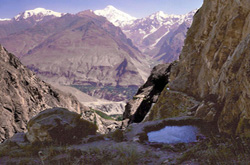The Hindu Kush-Himalayan region - Geology
From the Pamir Mountains plateau at the border of Afghanistan and the North-West Frontier Province of Pakistan, the Hindu Kush-Himalayan region extends over some 3,500 km to its south eastern borderline in Bangladesh, Bhutan, and Myanmar. Southward the Indo-Gangetic plains border on the HKH region, which extend from the Indus valley in Pakistan to the Brahmaputra valley in India (Assam) and the lowlands of Bangladesh. In the north the mountain system is bordered by the high Plateau of Tibet.
The Himalaya comprises a region of recent and continuing tectonic uplift which began less than 130 million years ago. The great areas of metamorphic rocks in the central core of the Himalayan have been dated to the Tertiary (started before 65 million years and ended 1.6 million years ago) as a direct result of the great mountain building process. Predominantly, crystalline and metamorphic rocks make up this central Himalayan zone with granites, gneisses, schists, and sediments. Nevertheless, the Hindu Kush-Himalayan ranges contain rock series from all major periods. Thus in the eastern Himalayas there are examples of Archaean (more then 2.5 billion years old) basement gneiss, while the lower ranges along the southern flank comprise a complex set of younger Tertiary sedimentary deposits, including riverine deposits by rivers emerging onto the plains from the Himalayas.
 |
Skardu Hills in Pakistan. |